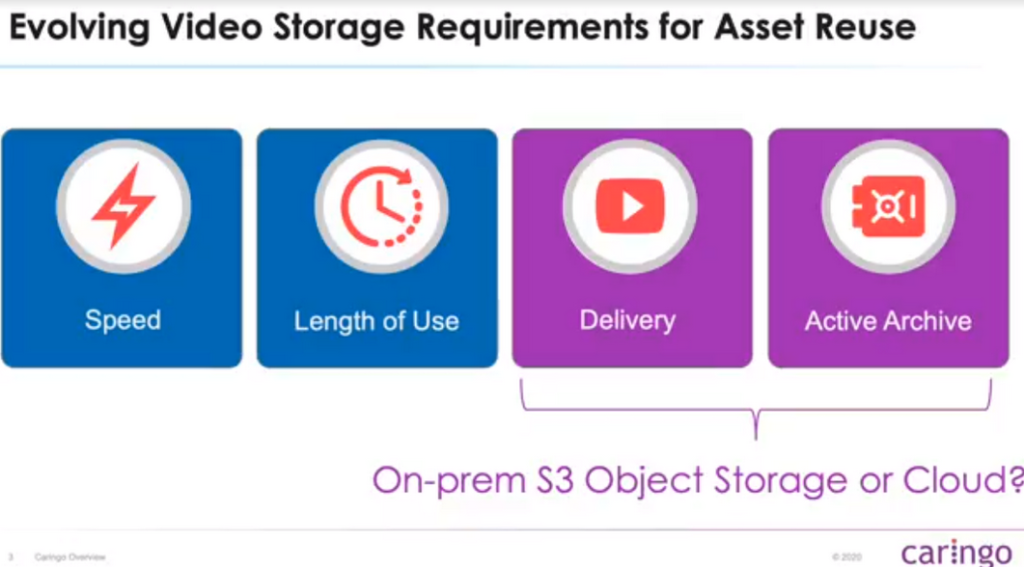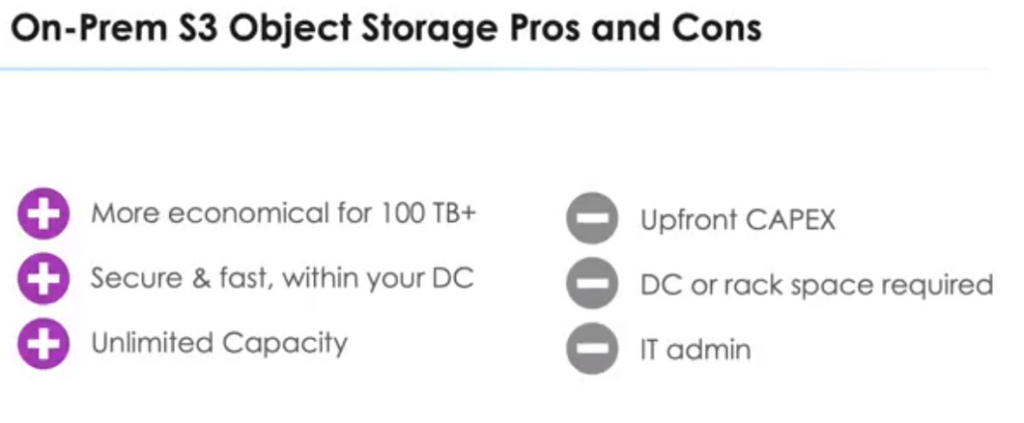HITS

M&E Day: Caringo Weighs Pros, Cons of Archiving Content On-Prem vs. Cloud
Story Highlights
Although the cloud should undoubtedly be part of a media organization’s remote workflow strategy, companies still find themselves weighing whether archiving content on-premise or in the cloud makes the most sense for them, according to Paul Phillips, who heads sales and operations for the Europe, Middle East and Africa (EMEA) region at object storage service provider Caringo.
It is clear that archives must remain instantly accessible over the web, but there are options out there when it comes to reliably providing that availability. There are also options that are more economical than the cloud.
“Getting your content quickly and easily is a huge operational advantage for the many value streams that rely on content availability,” Phillips said July 2 during the cloud breakout session “Point Break: When to Archive Content On Prem or in the Cloud” at the Global Media & Entertainment Day event presented live, virtually, from London.
During the session, he addressed the differences between cloud storage and on-premises object storage, how to determine which storage solution is right for your content archive needs, and the benefits of on-premises object storage and hybrid storage solutions.
“There’s no dispute that tape plays a key role for many organizations,” he noted. “However, in our humble opinion, it does not typically offer the power or the functionality of a well-architected actual archive that can provide instant access with high levels of security and data integrity and some really very cool features,” he said.
 There are, meanwhile, “evolving video storage requirements for asset reuse,” he pointed out. “In recent times, the criteria people have been looking for when they’re architecting something has moved in focus. In past times… some of the key metrics that shaped how the solution proposal [to customers] was architected were speed of retrieval and the frequency the content being discussed would be accessed,” he noted.
There are, meanwhile, “evolving video storage requirements for asset reuse,” he pointed out. “In recent times, the criteria people have been looking for when they’re architecting something has moved in focus. In past times… some of the key metrics that shaped how the solution proposal [to customers] was architected were speed of retrieval and the frequency the content being discussed would be accessed,” he noted.
However, “recently, the reoccurring theme is the choice between a carefully architected on-prem, S3-enabled object-based active archive and a commercial cloud strategy,” he noted, then provided the pros and cons of on-prem and commercial cloud.
“For on-prem, in our case, we are far more effective and [provide a] far greater return on investment as you scale into hundreds of terabytes,” he said, adding: “By the very definition, if we’re on-premise, you have the benefit of your own power and cooling and, possibly most importantly, your own inherent network connectivity and speeds. With pre-planning,” using Caringo’s Swarm software-defined object storage system, “unlimited access to unlimited capacity is easily planned and achieved,” he said.
Meanwhile, “the cons” include a “capital expenditure element, as you would expect,” he noted, adding: “We do [also] need a degree of rack space and even a beautifully architected solution will require a degree of IT administration going forward.”
He went on to explain the pros and cons of commercial cloud through a similar “Caringo lens.”
It is “undisputed that you can actually start small and pay as you grow,” he pointed out, adding: “I think you could, if you were really committed, reduce or even eliminate your data center operations. And, much like our on-prem solution, you can have easy access to unlimited capacity.”
However, he said: “Some of the cons are … you are certainly going to accrue ongoing and compounding costs. There’s, [meanwhile], lots of stories about ingress and egress charges and speed. But something that is not so often discussed is the fact that, in our experience, customers that are about to incorporate a commercial cloud service with an existing or sophisticated workflow are finding that they need a rolling DevOps budget and, of course, those DevOps professionals to be able to actually execute the changes and build those workflows.”
Based on his opinion and recent experience, he went on to point out the most common points that inform the choice between cloud or on-prem.
“By way of a cheeky spoiler alert, you can, of course, incorporate the best of all of these elements to put together your own fully hybrid approach,” he said. However, when it comes to capacity considerations, “over 100 terabytes on-prem will swiftly return your investment versus a major cloud service,” he said.
When it comes to rack space considerations, he said: “From a Caringo perspective, our own appliances are ultra-dense. Currently, they are for 200 terabytes including compute in 1u. Of course, there are no physical hosting considerations with a cloud service.”
When it comes to ingress (or speed to store), he noted: “On-prem runs at your internal network speed. Commercial cloud is tied to your connection speed, which can be disparate. If you’re a geographically dispersed organizational work group, the cloud still makes great sense, but the upload and download speeds can be disparate.”
 Similarly, when it comes to egress (or time to access), he noted, “on-prem runs at your internal network speeds [and] commercial cloud speeds can be disparate.”
Similarly, when it comes to egress (or time to access), he noted, “on-prem runs at your internal network speeds [and] commercial cloud speeds can be disparate.”
He also highlighted the benefits of one Swarm feature: “True Partial File Restore, which enables content to be accessed, viewed, clipped, transcoded, even have rich metadata applied and then delivered – all while the original content remains in its origin location,” he said.
And, when it comes to cost, he explained: “On-prem, S3-enabled object storage solutions really start to pay off when you have a requirement for secure, long-term retention of your content, coupled with strategic or regular predictable access.” Meanwhile, commercial cloud service is “truly rapid start” and the cost typically scales as a project grows, he concluded.
The fourth annual M&E Day event, presented by the Media & Entertainment Services Alliance (MESA), featured mainstage panels and more than 15 breakout sessions, covering the latest it data, cloud, IT and security across the media and entertainment technology ecosystem.
The event was presented by Caringo, with sponsorship by Convergent Risks, Cyberhaven, Richey May Technology Solutions, RSG Media, Signiant, Whip Media Group, Zendesk, Tape Ark, Sony New Media Solutions, 5th Kind, ATMECS, Eluvio, Tamr, the Audio Business Continuity Alliance (ABCA), the Entertainment Identifier Registry (EIDR) and The Trusted Partner Network (TPN).









